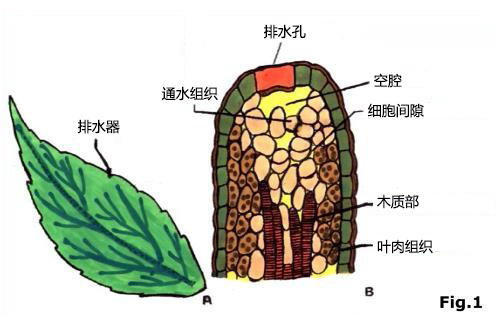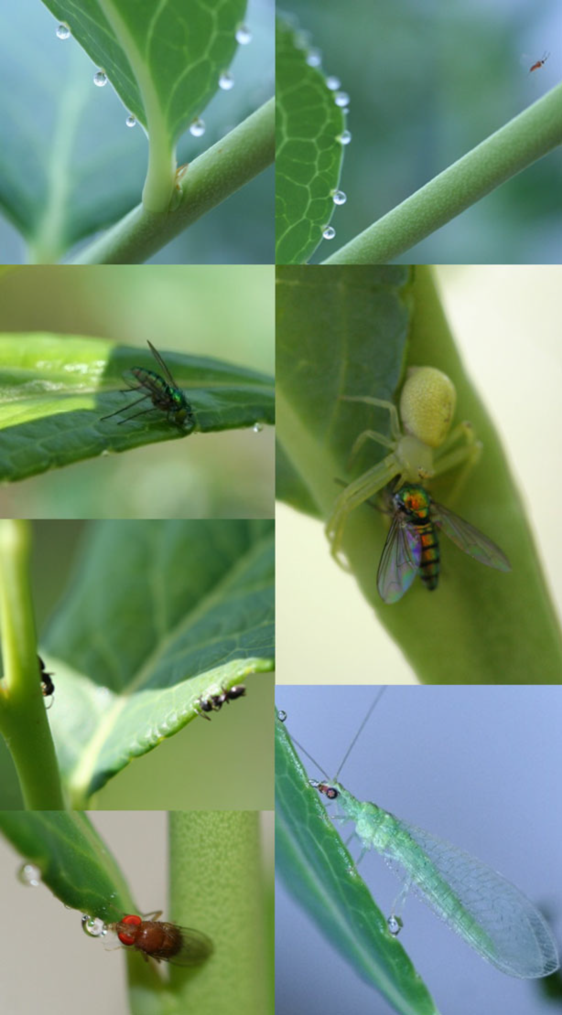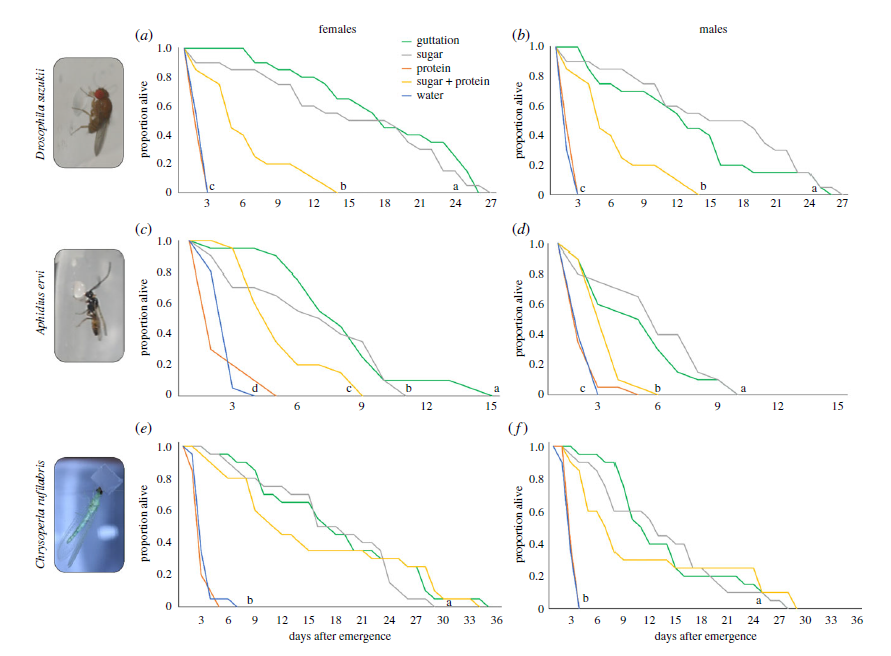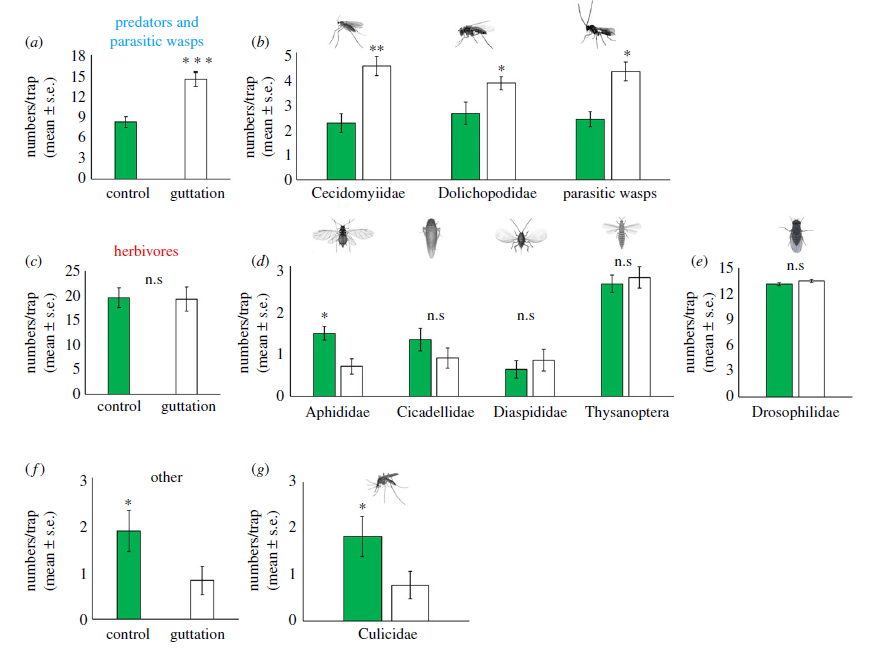Nourishing natural enemies to protect themselves, the plants vomit water are so amazing
Author:Look at the think tank Time:2022.07.31
Have you ever noticed this phenomenon: the top or edges of some plants are always full of shiny crystal water droplets.
Maybe many people think that this is dew. However, this is not. Dewdrops are generally covered with leaves, forming a layer of water film on the surface of the leaves, and there is no regular arrangement of water droplets. But these water droplets are neatly arranged on the edge of the leaves.
This wonderful phenomenon is called Guttation, which often occurs in the growth period of plants.
Wen | Liao Xinfeng
This article is reproduced from the WeChat public account "Science China" (ID: science_china). The original first was released on July 23, 2022. The original title was "Plants and insects actually doing such things at night ..." does not mean Watching think tank viewpoint.
1
Plants vomiting water are not uncommon
Some people observed the phenomenon of plant spit more than 300 years ago, but at that time, people only regarded it as an accident. As more and more plants (especially herbal plants) have been found, the phenomenon of spitting water is found. Plants have been identified as common phenomena by today's academic circles, and they also officially have their names.
The spitting phenomenon of plants is not uncommon. Many common plants such as rice, wheat, barley, sugarcane and other common plants have spitting water in the growth season. Different from the injury or gum phenomenon of plants, spitting water is not a plant that secretes the liquid after injury, but is naturally formed to maintain a measure of water balance in the body.
In summer, the plant grows rapidly, metabolizes, and spitting water is even more frequent.
The phenomenon of spitting usually occurs at night, because at night, the roots of the plant are still constantly absorbing the water and inorganic salts in the soil. The phenomenon of bright crystal water drops on the edges.
Most of the spit water will be arranged on the edge of the blades. This is because the edges of the leaves are specialized in drainage tissue, called hydathodes, which are drained from the special air holes to the leaves. With an empty cavity to store moisture, the moisture is derived from the water -water tissue connected to the internal dimensions of the leaves.

Plant blades drainter structure, picture source: reference 1
2
Plants "vomit" water can feed a group of insects
Generally speaking, the "spitting water" of the plant can discharge excess water absorbed at night, which plays an important role in maintaining the water balance in the body and the water balance in the body.
Not only that, in subsequent studies found that the drainacer and vascular tissue of the blades are connected together. Researchers speculate that "vomiting" water may also contain other substances that are transported by vascular transportation, such as minerals, sugar, protein, etc.
Scientists have also discovered that many insects can take small water droplets formed by planting water, but they first only thought that these insects were simply supplementing water.
The breakthrough of the conclusion of "plant spit water contains a lot of nutrition" comes from blueberries. Scientists found that the blueberry not only spit the water amazing, but also was welcomed by insects.

The phenomenon of blueberry spitting water, and various insects that eat water, picture source: reference 2
This shows that plant vomiting water may not just be the source of insects, but also an important source of food for insects.
To verify this conclusion, scientists have collected blueberry spit water, and at the same time collected three insects that often collect water spit out of blueberries: including a drosophila suzukii, which belongs to herbivore insects, a parasitic bee (Aphidius Ervi), and a parasitic bee. It is a parasitic insect and a chrysoperla runris. It is a predatory insect, which represents three different nutrition levels.
Next, scientists "spit" water, pure water, sugar, pure protein and sugar protein mixture of the collected blueberry plants to feed the three insects.
It was found that the insects with only pure water could not survive. Drinking water insects with blueberry plants, insects drinking sugar water, and insects that drink mixed liquids can survive. The insect life of "vomiting" water of blueberry plants or even insects fed with sugar water.

After feeding different nutrient solution, the three different insects of insects, green lines indicate the vomiting fluid of the blueberry, picture source: reference 2
Not only that, scientific researchers will also mate with insects and females with different nutrient solutions to make them spawn after fertilization and check whether their egg yield will be affected. The results showed that the insects that vomited water were not affected, and the vomiting of blueberry plants was "natural nutrient solution".
Through measurement, scientists also found that the content of water and protein of blueberry spitting water is very high, reaching 1.5 grams per milliliter and 4.3 mg per milliliters, respectively. The content of sugar in the nectar is about 0.4 grams per milliliter. The water of the blueberry plant "spit" is three times higher than the sugar content of the nectar. (Such nutritional, the author has the impulse to drink blueberry "vomiting").
Therefore, it is a very good source of nutrition for insects that eat blueberries. This may be the fourth largest category of nutrient production in addition to pollen, nectar and honey. In addition, it is better for plants to vomit water.
Plants are rich in nutrients. Is it just to support insects? According to the laws of nature, things must not be so simple.
3
Nourish natural enemies to protect yourself
The blueberry "vomiting" so much water is still an open resource. It seems that if insects are in the first place, they can take a bite. So, will this spit phenomenon attract a large amount of herbal insects, not only drinking the "spit" water, but also the plant leaves?
In the wild experiment, scientists surveyed the insect communities attracted to the water spitting water. In the wild, there are a large number of insects to eat blueberry spit water. Compared with the blueberry plant that removes the water artificially, the spit plant has obviously attracted more parasitic bees, predating insects such as grasshoppers, but the attractive herbivores The number of sex insects has decreased a lot.
That is to say, the blueberries have attracted more natural enemies through the "vomiting" water, which can better protect themselves.
Compared with the control group, the blueberry plants that spit water have attracted more predatory insects and parasitic insects.

What's more interesting is that the number of mosquitoes has decreased significantly on the plant of the spit. It may be because of the deterrent of other predators, mosquitoes have to give up this nutrients. This may be a new type of anti -mosquito method.
Spitting water is quite common in crops. If you can control the "spit formation" of crops, maybe a new biological control can be achieved, allowing crops to attract more predatory insects to fight natural enemies, "borrow knives to kill insects", realize it Insects from top to bottom.
Plants vomiting water is not only an important way to regulate the plant with important water balance, it also has important ecological functions. It is controlled by the material in the spit water to control the "circle of friends".
Perhaps one day, the substances contained in the spitting water of the plant can also be enriched to a matter. In this way, we can not only collect the fruits of blueberries, but also harvest the water of blueberry spitting water to achieve natural blueberry "spit water" juice, delicious and nutritious. I wonder if you are willing to try it at that time?
Reference materials:
[1] Mondal, FLS, FIAAT, AMAL. (2014). Guttatin-A Nortural Phenomenon: Useful Medium for Production of Recombinant Proteins.
[2] Urbaneja-Bernat P, Tena A, González-Cabrera J, et al. Plant guttation provides nutrient-rich food for insects[J]. Proceedings of the Royal Society B, 2020, 287(1935): 20201080.

- END -
If someone throws a missile, what should we do?

The following article comes from WeChat public account: Mixed know, the author kno...
Korean scholar: China's ambition is difficult to stop
World Newspaper Cindyga's article on June 27, original title: How realistic is China's semiconductor ambition?Bayeng arrived in South Korea last month -as the first visit to South Korea as a US presid...